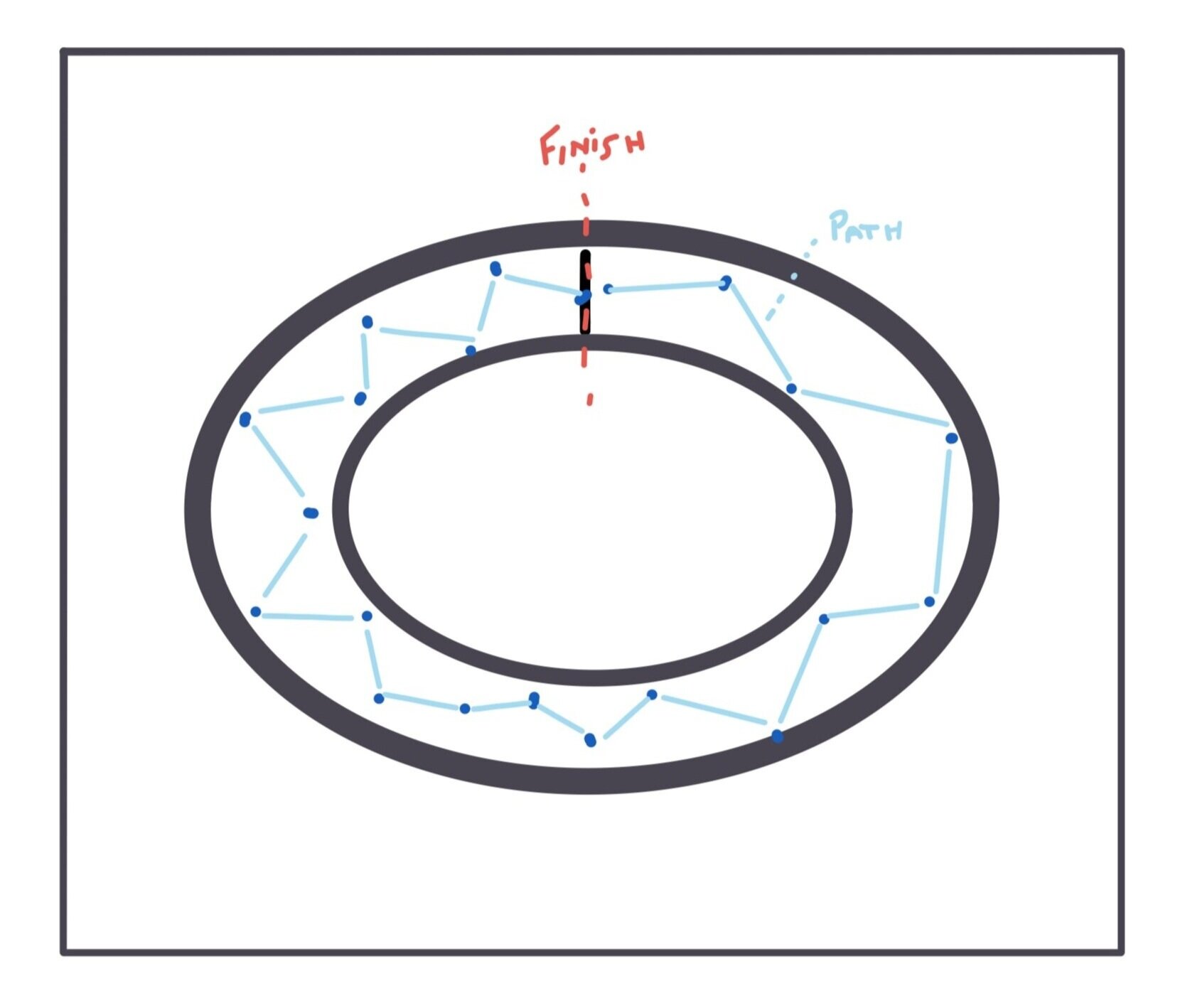This week, we covered Genetic Evolution algorithms and surveyed a few approaches to designing simulations that implement this technique. Below, I’ll lay out a plan for a simulation in p5.js that takes inspiration from the improvement in athletic performance over the last 100+ years.
Scenario
Describe the scenario. What is the population? What is the environment? What is the "problem" or question? What is evolving? What are the goals?
When we watch athletes compete today, it is remarkable just how far they’re able to push the human body to achieve the feats they achieve during the games. Crowds at earlier athletic events were similarly mesmerized by the best athletes in the world during their eras. However, when we watch film of athletic competitions even 30-40 years ago, it often seems like we’re watching an amateur version of today’s sport. When we look at world record times for competitions like the 400m dash, we see a steady improvement over the years; most likely these are due to advances in technology, diet, strategy, training methods and other tools more readily available to modern athletes.
This steady march towards reaching an upper limit on athletic performance reminds me of a genetic evolution simulation. Thousands of athletes have tried to run around a track as fast as they could. Each generation of new athletes learns from the previous ones and finds little ways to improve. Over time, we see world records broken, little by little.
I would like to build a simulation that has objects try to “run” around a “track” as quickly as they can, under a number of constraints that loosely model those of real athletes. The viewer will be able to manually run each generation rather than having the simulation evolve as fast as possible, and we’ll record “world record” for the best individual “athlete” in that generation’s competition. We can display a record book on screen to see how the world records vary and eventually improve over time. We can also display the “stats” for the top n athletes to see how things like “strategy,” “technology,” and “muscle mass” change over time as the athletes improve.
Phenotype and Genotype
What is the "thing" that is evolving? Describe it's phenotype (the "expression" of its virtual DNA) and describe how you encode its genotype (the data itself) into an array or some other data structure.
Athletes, represented by shapes on the screen, are the “things” that are evolving. The athletes will be physics objects that have a position, velocity and acceleration. They’ll also have other traits like “strategy” and “technology” that loosely model real world factors that can limit or increase their max speed and vary from generation to generation. Instead of thinking of technology/strategy as properties of the object, they could be thought of as forces that are applied to the object’s acceleration or velocity vector and vary from object to object in the system.
Strategy will control the efficiency of the path taken on the track. Each frame, the object will have to decide the angle of its trajectory. If the object zig-zags around the track, it will not be taking the most efficient route. Over time, the objects should learn to take the path with the least amount of wasted movements to get to the finish line. The code will need to be written in a way that the object only goes clockwise, rather than immediately going to the finish line to the objects’ left.
The objects will also have other constraints besides knowing the best route to run. They’ll a “technology” constraint — this will correspond to a max speed or max force property’s ceiling that applies to all athlete objects. Each athlete object’s specific technologies will allow it to reach a percentage of the ceiling — with some having “better” technology, or a higher chance of reaching the ceiling, and some will only reach, say, 50% of the ceiling, which means they will likely complete the race slower than athlete objects with better technology.
Athlete objects will also have different diets that behave similarly to technology. Diet could potentially control a “max force” constraint that affects acceleration, or could be a small velocity multiplication factor that works in conjunction with technology. This factor would apply to all objects, and each individual athlete object’s diet could vary to allow it to have a percentage of the max factor.
These properties encode the genotype and allow the athlete the potential to perform as well as their ceilings will allow them to perform. Over time, those ceilings will go up, which will allow individual athletes to go faster than the fastest in the previous generations.
The athletes’ phenotype, or expressed traits, will be their shapes and speeds of movement around the track. Perhaps diet can modulate size of the circle a bit and tech can change color or control some sort of blur effect.
Fitness Function
What is the fitness function? How do you score each element of the population?
Each generation, 20 athletes will compete. The fitness function will look for the elapsed time for the athlete to reach the finish line. Assume an oval track where the athletes begin at the top of the canvas and run clockwise as shown above. The pseudo-code to calculate the fitness function will be something like:
If athlete.pos.x equals finish.pos.x and athlete.pos.y is between a range of finish.pos.y, trigger a function that will log the time elapsed since the start of the race and the point at which the if conditions are met..
Mutation and Crossover
Are there any special considerations to mutation and crossover to consider or would the standard approaches work?
Technology and diet ceilings should probably increase on some set interval -- maybe determined by user but set at a default of every 10 generations (like a decade). Crossover can continue in a standard way and so can mutation.


